How Much Astaxanthin Should You Take Daily? Dosage Breakdown

Astaxanthin—a red carotenoid pigment produced naturally by microalgae such as Haematococcus pluvialis—has earned acclaim as “nature’s most powerful antioxidant.” From skin protection and eye health to cognitive support, immune resilience, and athletic recovery, its benefits are well documented. But one question rises above the rest: How much astaxanthin should you actually take each day? In this guide, we’ll explore science‑backed dosage ranges for different health goals, the factors that influence your ideal intake, and practical tips for maximizing absorption and safety.
1. Why Dosage Matters
Effective supplementation balances efficacy and safety. Too low a dose may not deliver the antioxidant protection you seek; too high a dose offers diminishing returns, adds cost, and could—on rare occasions—lead to mild side effects. Because natural astaxanthin from microalgae exhibits higher bioavailability than synthetic forms, dosage recommendations assume you’re using a high‑purity, microalgal extract like Astadaily.
Your health goal also dictates the optimal intake:
-
General antioxidant support for everyday wellness
-
Skin and UV protection to preserve elasticity and defend against photo‑aging
-
Eye and vision health to support retinal function and reduce visual fatigue
-
Brain health to enhance cognitive function, focus, and protect neurons from oxidative stress
-
Athletic recovery to leverage anti‑inflammatory and muscle‑repair effects
By tailoring dose to goal, you get targeted benefits without over‑dosing—and you stretch your supplement investment further.
2. Recommended Daily Dose Ranges
Based on clinical studies and expert consensus, here are the typical daily ranges for adults:
| Goal | Dose (mg/day) | Rationale |
| General Antioxidant Support | 4–6 mg | Proven to boost overall oxidative balance and support longevity with minimal intake. |
| Skin & UV Protection | 6–8 mg | Higher doses show measurable improvements in skin elasticity, hydration, and resistance to UV. |
| Eye & Vision Health | 8–12 mg | Studies indicate benefits for macular health, reduced eye strain, and protection against light‑induced damage. |
| Brain Health | 6–12 mg | Emerging research suggests antioxidant support helps cognitive function, memory, and focus. |
| Athletic Recovery | 4–12 mg | Anti‑inflammatory action supports muscle recovery; higher doses can aid intense training recovery. |

Pro Tip for Beginners: Start at 6 mg/day—the amount in one Astadaily softgel—to assess how you feel. After 2–4 weeks, adjust toward your target range based on your specific goals and tolerance. Always consult your healthcare provider if you have underlying health conditions.
3. Factors That Influence Your Ideal Dose
Several personal and lifestyle factors affect how much astaxanthin you might need:
-
Body Weight & Metabolism
Individuals with higher body mass or faster metabolism may require doses at the upper end of the range to achieve equivalent blood concentrations. -
Dietary Antioxidant Intake
If your diet is already rich in berries, leafy greens, and other antioxidant sources, you may need less supplemental astaxanthin for similar benefits. -
Oxidative Stress Level
Smokers, heavy exercisers, frequent travelers, or those under chronic stress experience elevated free‑radical production—often benefitting from 8–12 mg/day for goals like eye, brain, or recovery support. -
Age & Health Status
Aging tissues (skin, eyes, brain) accumulate damage over time. Older adults or anyone with specific concerns (e.g., mild cognitive decline, macular degeneration risk) can consider the higher end of the dosage spectrum—always under medical guidance.
By weighing these factors, you can fine‑tune your dose for maximal benefit without excess.
4. Timing & Formulation Tips

Astaxanthin is fat‑soluble, meaning its absorption improves dramatically when taken with dietary fat. Follow these guidelines:
-
Meal Pairing: Take your capsule alongside a meal containing healthy fats (avocado, nuts, olive or coconut oil) to boost absorption by up to 40%.
-
Single vs. Split Doses:
-
Once Daily: Convenient for general wellness and most users.
-
Split Dosing: Two smaller doses (e.g., morning and evening) can help maintain steadier blood levels—ideal for cognitive focus during the day and overnight recovery.
-
-
Consistency: Take your supplement at the same time(s) each day to build a routine and ensure stable antioxidant support.
-
Capsule Quality: Opt for vegan, microalgae‑sourced natural esterified astaxanthin for superior stability and uptake.
A little planning around meal timing can make a significant difference in how much astaxanthin your body actually uses.
5. Safety & Side‑Effect Profile
Natural astaxanthin is generally well tolerated with an excellent safety record:
-
Typical Tolerability: Doses up to 12 mg/day show no serious adverse events in clinical settings.
-
Possible Mild Effects: Taking on an empty stomach may cause minor gastrointestinal discomfort in rare cases.
-
Contraindications:
-
Pregnant or nursing individuals should consult a healthcare professional.
-
If you’re on blood thinners or immunosuppressants, discuss potential interactions with your doctor.
-
To minimize risk:
-
Start at the baseline 6 mg/day and monitor how you feel.
-
Adjust gradually within your target range.
-
Keep within 4–12 mg/day unless directed otherwise by a qualified professional.
By starting at one softgel (6 mg) and staying within the 6–12 mg range, you’ll harness astaxanthin’s powerful benefits while maintaining an excellent safety profile—giving you confidence to make it a lasting part of your daily wellness routine.






Leave a comment